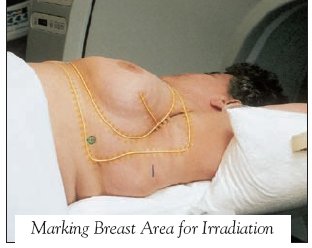 |
Although controversy has existed concerning the need for delivering an additional boost
dose to the primary site, there is growing consensus about its utility. Although boost
irradiation generally is used, the precise indications for its use are not well defined.
However, research indicates that a boost should be used in patients with focally positive
or close margins of resection.
Boost irradiation usually is delivered using electron beam or interstitial implantation. The total dose to the primary tumor site is increased to approximately
6,000 to 6,600 cGy. Selection of the boost dose and volume should be based on
knowledge of the surgical procedure and the pathologic findings. In situations where an
electron beam boost and an interstitial implant boost are judged to be equally effective,
an electron beam is generally preferred because of considerations of cost, patient
convenience, and cosmesis.
A boost may not be required for patients who have been treated with more extensive breast
resections and have margins of resection that are clearly negative. If the breast boost is
omitted in these patients, the only available data indicate that the standard whole breast
radiation therapy dose is 5,000 cGy at 200 cGy per fraction. |


